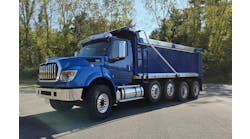There was a time when people asked about you and your family and meant it. Parents were the only babysitters. Rip Van Winkle slept 20 years and no one asked him to endorse a mattress.
Scientists of old developed the notions of gravity, electricity and the solar system.
Years later, scientists came up with spray cheese, stretch denim and reality TV programs.
More recently, researchers created voicemail systems that enable you to avoid talking to another individual, and then introduced smartphones and computer tablets.
Real-time remote vehicle diagnostics systems have the ability to unobtrusively, continuously obtain data regarding vehicle behavior and on-the-road status.
Commercial vehicles are running on electricity, advanced hybrid technologies and all types of alternative fuels, even landfill gas.
Change, and its impacts, is inevitable and hard to predict.
To be sure, though, technology will continue to drive change with regard to how vehicles are operated, maintained, serviced and repaired.
Change Point
Many changes seem to occur at the close of each year, as this is the time we ponder adjustments and make our resolutions for the New Year.
This issue’s cover story - Maintenance Outlook Report - provides a collection of viewpoints and perspectives, from a range of industry companies, on how developments over the next few years may affect vehicle maintenance.
The intent is to provide some insight to help you better understand the forces and influences that shape our industry so you can better prepare for tomorrow.
Easier Transmissions
Among the many changes that have been occurring within the trucking industry is the evolution of automatic and automated transmissions for heavy trucks. A chief reason for this is to make things “easier” on the driver and driveline, and help increase fuel economy.
One automated transmission that has been progressing is Volvo Trucks’ I-Shift - a 12-speed automated mechanical transmission (AMT) that requires no clutch pedal and is operated by intelligent electronics.
The Start
Courtesy of Volvo Trucks, I had the opportunity in late October to travel to Sweden to visit with the father of the I-Shift - Sven-Erik Tibb, manager, drivelines and hybrids - and the principal software designer for the transmission - Anders Eriksson, design engineer - software.
Volvo Trucks began automating transmissions in the early 1980, Tibb told me, and came up with the Geartronic transmission - the company’s first AMT.
He noted that Volvo Trucks has an advantage over some truck OEMs because it has a proprietary powertrain, so all components are designed from the start to be integrated to work well together.
The first generation I-Shift was introduced in Sweden in 2001. It came to North America in 2007, and now is spec’d on more than 40 percent of all new Volvo-powered trucks.
The I-Shift features an integrated gear-changing system with all functions electronically controlled, said Tibb.
Now in its fourth generation of automated mechanical transmission technology, the I-Shift is based on proven technology that requires minimal service and virtually no maintenance.
Intelligent Transmissions
The I-Shift is an intelligent transmission because it is integrated into the powertrain’s hardware and software, explained Eriksson. The I-Shift knows all engine characteristics for each and every engine rating, and matches the appropriate transmission gear so that the engine always runs in the “sweet spot” for the best performance and fuel economy.
The I-Shift’s transmission management system knows the efficiency map for each Volvo engine, he said. By continuously monitoring the changing grade, vehicle speed, acceleration, torque demand, weight, rolling and air resistance, the transmission can instantly predict and select the most efficient utilization of the engine.
In other words, it knows when and where a shift would be beneficial, thereby putting less stress on the driveline, for longer life and less maintenance.
The I-Shift comes with Economy and Performance operating modes, said Eriksson. In the Economy mode, the transmission will select shift points and command engine parameters to maximize fuel efficiency. The Performance mode maximizes gradeability.
The I-Shift can be operated manually through an up-and-down gear selector button and a mode switch. All the manual range-change and splitter gearboxes feature Volvo’s patented servo synchro system which reduces gear-changing forces by up to 50 percent.
Effective Planning
Good information, strategic insight, solid preparation, effective training and enlightened management are all elements to making wise business decisions - both now and for the future.
I recall something my dear father once told me. He said that planning is all about bringing the future into the present so that you can do something about it now.
This month’s cover story will help you do this.




